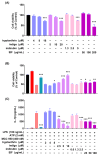Isatidis Folium Represses Dextran Sulfate Sodium-Induced Colitis and Suppresses the Inflammatory Response by Inhibiting Inflammasome Activation
- PMID: 39408295
- PMCID: PMC11478736
- DOI: 10.3390/nu16193323
Isatidis Folium Represses Dextran Sulfate Sodium-Induced Colitis and Suppresses the Inflammatory Response by Inhibiting Inflammasome Activation
Abstract
Background/objectives: Isatidis Folium (IF) has been used in traditional medicine for various ailments, and recent research highlights its anti-inflammatory, antiviral, and detoxifying properties. This study investigated the anti-inflammatory effects of a hydroethanolic extract of IF (EIF) on inflammasomes and colitis.
Methods: Dextran sulfate sodium (DSS)-induced colitis model C57BL/6 mice were treated with DSS, mesalamine, or EIF (200 mg/kg). Parameters such as daily disease activity index (DAI), spleen weight, colon length, and histopathology were evaluated. Intestinal fibrosis, mucin, and tight junction proteins were assessed using Masson's trichrome, periodic acid-Schiff, and immunohistochemistry staining. RAW264.7 and J774a.1 macrophages were treated with EIF and lipopolysaccharide, with cell viability assessed via the cell counting kit-8 assay, nitric oxide (NO) production with Griess reagent, and cytokine levels with the enzyme-linked immunosorbent assay. NF-κB inhibition was analyzed using the luciferase assay, and phytochemical analysis was performed using UPLC-MS/MS.
Results: EIF mitigated weight loss, reduced DAI scores, prevented colon shortening, and attenuated mucosal damage, fibrosis, and goblet cell loss while enhancing the tight junction protein occludin. The anti-inflammatory effects of EIF in RAW264.7 cells included reduced NO production, pro-inflammatory cytokines, and NF-κB activity, along with inhibition of NLRP3 inflammasome responses in J774a.1 cells. The key constituents identified were tryptanthrin, indigo, and indirubin.
Conclusions: Animal studies demonstrated the efficacy of EIF in alleviating colitis, suggesting its potential for treating inflammatory diseases.
Keywords: Isatidis Folium; anti-inflammatory agents; caspase-1; inflammasome; macrophages; ulcerative colitis.
Conflict of interest statement
The authors declare no conflicts of interest.
Figures








Similar articles
-
Canna x generalis L.H. Bailey rhizome extract ameliorates dextran sulfate sodium-induced colitis via modulating intestinal mucosal dysfunction, oxidative stress, inflammation, and TLR4/ NF-ҡB and NLRP3 inflammasome pathways.J Ethnopharmacol. 2021 Apr 6;269:113670. doi: 10.1016/j.jep.2020.113670. Epub 2020 Dec 8. J Ethnopharmacol. 2021. PMID: 33301917
-
Proteomic analysis reveals that Acalypha australis L. mitigates chronic colitis by modulating the FABP4/PPARγ/NF-κB signaling pathway.J Ethnopharmacol. 2025 Apr 9;345:119585. doi: 10.1016/j.jep.2025.119585. Epub 2025 Mar 4. J Ethnopharmacol. 2025. PMID: 40049341
-
BAFF Blockade Attenuates DSS-Induced Chronic Colitis via Inhibiting NLRP3 Inflammasome and NF-κB Activation.Front Immunol. 2022 Mar 7;13:783254. doi: 10.3389/fimmu.2022.783254. eCollection 2022. Front Immunol. 2022. PMID: 35320937 Free PMC article.
-
Anti-colitic effects of Physalin B on dextran sodium sulfate-induced BALB/c mice by suppressing multiple inflammatory signaling pathways.J Ethnopharmacol. 2020 Sep 15;259:112956. doi: 10.1016/j.jep.2020.112956. Epub 2020 May 19. J Ethnopharmacol. 2020. PMID: 32442587
-
Intestinal anti-inflammatory effects of fuzi-ganjiang herb pair against DSS-induced ulcerative colitis in mice.J Ethnopharmacol. 2020 Oct 28;261:112951. doi: 10.1016/j.jep.2020.112951. Epub 2020 Jun 20. J Ethnopharmacol. 2020. PMID: 32574670
Cited by
-
Analysis and prediction of immune cell infiltration characteristics in COPD: Folium isatidis and its active ingredients are able to combat lung lesions caused by COPD by correcting immune cell infiltration.Front Med (Lausanne). 2025 Apr 23;12:1584411. doi: 10.3389/fmed.2025.1584411. eCollection 2025. Front Med (Lausanne). 2025. PMID: 40337271 Free PMC article.
-
Exploration of biophoton characteristics of fresh Isatis indigotica fort leaves under salt and drought stresses and the feasibility analysis for the quality prediction of Isatidis Folium.Front Plant Sci. 2025 Mar 12;16:1523636. doi: 10.3389/fpls.2025.1523636. eCollection 2025. Front Plant Sci. 2025. PMID: 40144761 Free PMC article.
References
MeSH terms
Substances
LinkOut - more resources
Full Text Sources
Miscellaneous

